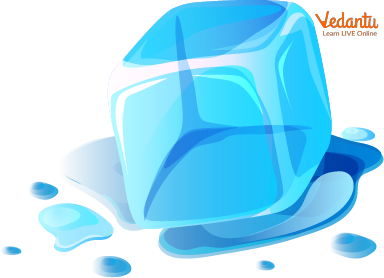




An Introduction to What is Freezing
Freezing and Melting are phase changes that occur when the states of a solid or liquid change. Freezing is the scientific process by which a liquid transforms into a solid due to decreased energy in its particles. This is frequently caused by cooling. The freezing point is the temperature at which a liquid solidifies.
Freezing is one of the oldest and most commonly used ways of food preservation which allows for the best preservation of taste, texture, and nutritional content in foods. In this article, melting point, freezing point, and the difference between them will be discussed.

Melting and Freezing
What is Freezing?
In chemistry, freezing is the scientific process through which a liquid transforms into a solid due to decreased energy in its particles. This is frequently caused by cooling. In most cases, this is the same as the melting point. Freezing is a reversible change, which means that once frozen is done then it can be returned to its original liquid condition.
Freezing is one of the oldest and most commonly used ways of food preservation which allows for the best preservation of taste, texture, and nutritional content in foods. Freezing prevents harmful microorganisms from developing on food that might otherwise grow at room temperature. As a result, suitable items can be safely consumed months after their original expiry date.
Example of Freezing
Lava freezing into rock magma is a molten rock combination that exists under the Earth's surface. Lava is the material taken from a volcano when it is discharged. Magma has a temperature range of 700-1300 °C which makes it very hot. Due to this, high-temperature lava transforms into a liquid. As a result, the lava cools and forms into the rocks.
What is Melting?
In Science, melting is the conversion of a solid into a liquid when the temperature rises. The melting point is the temperature at which a solid substance liquefies. Melting happens when the internal energy of a solid rises. The major reasons for melting food in terms of food production and preparation include chocolate moulding, the manufacturing of processed cheese, the processing of oils and fats, and the recovery of animal fat from meat wastes.

Melting of Ice
Example of Melting
Light bulbs are an excellent example of how melting is used in our daily life. The filament of light bulbs is made of tungsten metal. The metal in the bulb filaments must be heated to extremely high temperatures to create light. The tungsten metal has the greatest melting point as compared to other metals. It is used in light bulbs. Glassmaking is another common application for melting. In glass melting furnaces, raw materials are melted at temperatures ranging from 1500°C to 1700°C.
Differences between Melting and Freezing Points
Melting and Freezing Point of Water
The freezing point represents the liquid-to-solid transformation, whereas the melting point is the temperature at which water changes from a solid (ice) to liquid water. Water has a freezing and melting point of 0 °C or 32 °F. The temperature may be less if supercooling occurs. Water may stay a liquid as cold as -40 to -42°F under certain conditions.
Summary
In this article, we studied melting and freezing points. Freezing is the scientific process through which a liquid transforms into a solid due to decreased energy in its particles. Freezing is one of the oldest and most commonly used ways of food preservation and melting is the conversion of a solid into a liquid when the temperature rises. The major reasons for melting food in terms of food production and preparation include chocolate moulding and the manufacturing of processed cheese.
FAQs on What is Freezing? Knowing the Difference between Freezing and Melting
1. What is the main difference between freezing and melting?
The main difference lies in the change of state and the flow of heat. Melting is the process where a solid turns into a liquid by absorbing heat (e.g., ice turning into water). Freezing is the opposite process where a liquid turns into a solid by releasing or removing heat (e.g., water turning into ice in a freezer).
2. What happens to the molecules of water when it freezes?
When water freezes, its molecules lose energy and slow down. They stop moving freely past one another and arrange themselves into a fixed, hexagonal crystal structure. This organised pattern is what gives solid ice its definite shape and makes it hard.
3. Can you give some common examples of melting in daily life?
Yes, melting is a common process we see every day. Some examples include:
- A cube of butter turning to liquid in a hot pan.
- An ice cream cone dripping on a sunny day.
- A chocolate bar left in a warm place becoming soft and gooey.
- The wax of a lit candle turning into a liquid near the flame.
4. Are the freezing point and melting point of a substance always the same?
Yes, for a pure substance like water, the freezing point and melting point are the same temperature. For water, this is 0° Celsius (32° Fahrenheit). The term used simply depends on the direction of the change. It's called the melting point when a solid is heated to become a liquid, and the freezing point when a liquid is cooled to become a solid.
5. Why does ice float on water if they are both the same substance?
Ice floats on water because it is less dense than liquid water. When water freezes, its molecules expand and form a crystal structure with more empty space between them. This expansion means a block of ice takes up more volume (is bigger) than the same mass of liquid water, causing it to be lighter for its size and therefore float.
6. Why do people sprinkle salt on icy roads in cold countries?
People sprinkle salt on icy roads because salt lowers the freezing point of water. This means the ice on the road will melt even if the air temperature is below the normal freezing point of 0° Celsius. This process helps to clear the ice, making the roads less slippery and safer for travel.
7. Do all solids melt at a sharp, fixed temperature like ice?
No, not all solids have a fixed melting point. Solids like ice, salt, and metals are crystalline solids with an orderly arrangement of particles, so they melt at a single, sharp temperature. However, materials like glass, plastic, and butter are amorphous solids, meaning their particles are not arranged in a neat pattern. They soften gradually over a range of temperatures instead of melting at one specific point.





















